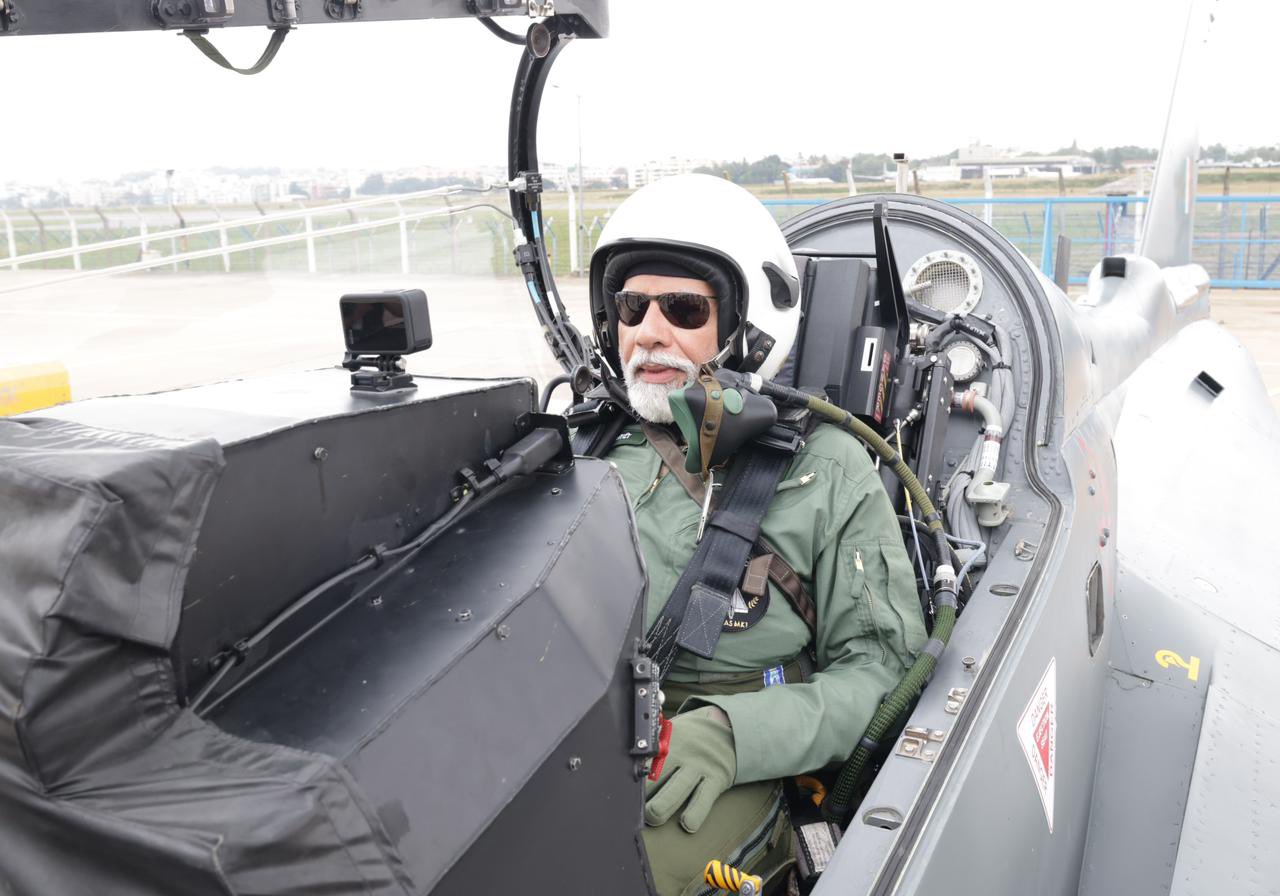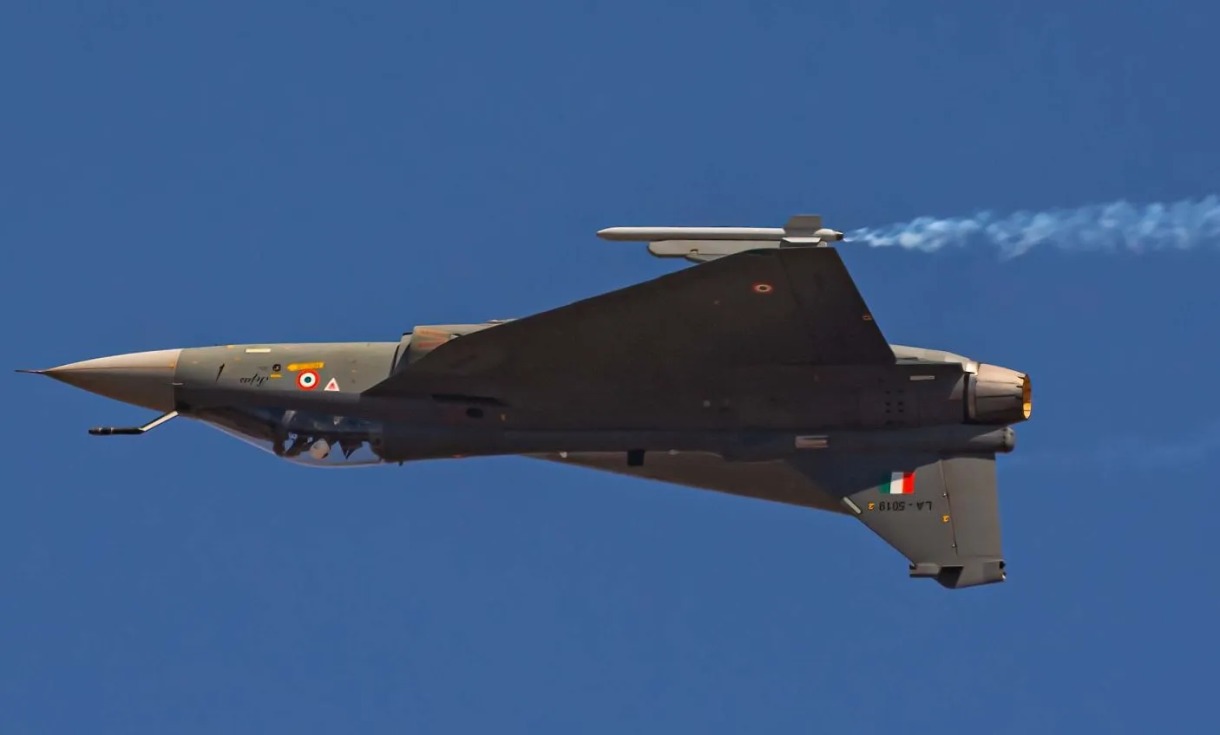After making its international debut in a global exercise in 2023, India’s home-built Light Combat Aircraft (LCA) ‘Tejas’ is already making head turns in the biggest multilateral exercise hosted by the Indian Air Force (IAF). The indigenous fighter jet successfully intercepted the Eurofighter Typhoon in a simulated combat scenario.
Tarang Shakti (literally meaning Power of Waves) is the largest international air exercise being conducted in India. Invitations were extended to 51 countries. Ten countries have confirmed participation with their assets, and 18 countries have confirmed their presence as observers.
The exercise was kicked off at the Sulur air base in South India. In his swashbuckler style, IAF Vice Chief Air Marshal AP Singh piloted the indigenous fighter jet and intercepted the German Air Force’s Eurofighter Typhoon flown by German Air Force Chief Lt Gen Ingo Gerhartz.
“I flew in today, and it was great. The IAF aircraft came up and intercepted us. I am looking forward to flying in this exercise,” Lt Gen Gerhartz said. This was the first time the German Air Force participated in an air force exercise in India. The participation is indicative of the change in Germany’s Indo-Pacific policy.
LCA was on a combat air patrol mission during which the interception happened.
LCA’ Tejas’ has come a long way since its conception. The aircraft is becoming the backbone of the Indian Air Force (IAF), which has inducted the warplane into its inventory and will soon deploy it to its forward bases on the western front with Pakistan.
Reports indicate that Tejas will soon be deployed in operational roles in the northern sector, where it would have to go one-on-one against Pakistan’s F-16s and China-Pakistan Joint Venture JF-17 should conflict happen between these countries.
The participating countries simulated electronic warfare situations and air defense exercises against multiple opponents. The complexity of the exercises was augmented by the lack of common data links between the visiting air forces. Data links allow communication between aircraft and ground controllers.
“We have different data link systems, so we have to come up with procedures (to communicate) … I am sure European countries can learn from the IAF as they are flying different aircraft and with totally different procedures,” Lt Gen Gerhartz added.
Besides increasing interoperability among different air forces, Tarang Shakti is aimed at showcasing India’s indigenous platforms like LCA Tejas and helicopters like Light Combat Helicopter (LCH) Prachand. The first phase of the exercise will take place in Sulur, the home base of LCA Tejas, and the second phase will be in Jodhpur, the home of LCH Prachand.
The first squadron of the LCH, 143 Helicopter Unit, was raised at the Jodhpur Air Base. It is the only attack helicopter in the world that can operate in Siachen, the world’s highest battlefield.
Other Made in India equipment to be deployed are Netra AEW&C, Akash SAM, and some other weapon systems, which will be showcased at the ground events.
BrahMos, Akash, Scorpene Submarine Deals On Card As Brazilian Defense Delegations Set To Visit India
Maturing of LCA
The IAF inducted two squadrons of LCA in 2016. After final operational clearance, the aircraft was deployed in Sulur. The aircraft has now started operating from forward bases and participating in international exercises, reflecting the confidence of the Indian establishment in the Indigenous jet.
In 2024, LCA Tejas Mk1A, the advanced variant of the already inducted LCA Mk1, took to the skies, and the IAF placed one of the biggest defense orders for 83+97 of these fighter jets.
IAF, the fourth largest air force in the world, will soon operate around 350 LCAs (Mk-1, Mk-1A and Mk-2 variants). The force has already inducted 32 Mk1 (it has placed an order for 40 Mk-1 jets) and has placed an order for 83+97 of the Mk1A version.
In the coming decade, the IAF, grappling with a shortage of fighter jets, will have the homegrown LCA as the cornerstone of its combat power. The fighter jet will be equipped with Indian-built weapons.
The Indian Ministry of Defense announced in 2023 the successful firing of Astra, a Beyond Visual Range Air-to-Air missile developed by the Defense Research and Development Organisation (DRDO). Besides Astra, DRDO is developing Rudram1 anti-radiation missiles, anti-ship missiles, precision-guided ammunition, and glide bombs for LCA.
In 2023, Prime Minister Narendra Modi took to the skies on board Tejas, showing his confidence in the homegrown fighter jet. The move aims to boost LCA’s profile as an export product.

India’s bid to sell the Tejas to friendly foreign countries has not succeeded so far. In 2023, Tejas competed for attention against Chinese J-10C and Pakistan’s JF-17 Thunder Block-3 fighter aircraft at the Dubai Air Show.
LCA’s first serious attempt to win a contract was with Malaysia, which was looking to acquire 18 light combat jets. Despite being down-selected, LCA lost out to South Korea’s FA-50 jets there. Other nations have shown interest in Tejas jets, too. However, Argentina chose second-hand F-16s.
After successfully delivering the BrahMos supersonic cruise missile, India has been pitching LCA to the Philippines, too, where it is up against the South Korean FA-50. Nigeria has also expressed interest in buying the fighter jet.
The LCA Tejas Mk1A is an improvement on the LCA MK1 and is a single-engine, multi-role fighter aircraft designed for air superiority, ground attack, and reconnaissance missions. The four big feature changes that LCA Mk1A has are the AESA radar, air-to-air refueling, advanced electronics suite, and an advanced Beyond Visual Range missile.
The first LCA Mk1A was to be delivered to the IAF by the end of March; however, hurdles in engine delivery from the US have stalled the delivery.
The Mk1A variant incorporates modern avionics, including an active electronically scanned array (AESA) radar, an improved electronic warfare suite, and advanced sensors. AESA radar systems can scan and track targets almost instantaneously because they can generate multiple beams simultaneously.

This allows for improved situational awareness and faster response times in detecting and tracking multiple targets, reducing the likelihood of targets being missed or lost during high-speed or maneuvering scenarios.
The payload capacity has been enhanced, and Mk1A can carry a variety of air-to-air and air-to-ground munitions, including missiles, bombs, and rockets. Certain design changes have been made, and the aircraft has improved its maneuverability. The LCA Tejas Mk1A features enhanced agility and better control surfaces for dogfighting and close combat.
In whether the LCA Mk1A would be able to carry out Balakot-type airstrikes, former IAF chief Air Chief Marshal RKS Bhadauria (retired) had said: “In terms of strike capability, it will have the capability of a standoff weapon which will be even beyond the capability we used that time.”
So, the LCA Mk1A, with its advanced electronics suit, will detect the enemy warplane (like the JF-17) first and fire the indigenous BVR missile Astra to shoot it down.
The Indian fighter jet can carry air-to-air missiles like Astra (India’s first indigenous BVR), Derby (a medium-range BVR), and Python missiles. For air-to-ground weapons, it can carry precision-guided bomb Paveway, unguided rockets, and other precision-guided munitions.
- Ritu Sharma has been a journalist for over a decade, writing on defense, foreign affairs, and nuclear technology.
- The author can be reached at ritu.sharma (at) mail.com
- Follow EurAsian Times on Google News




